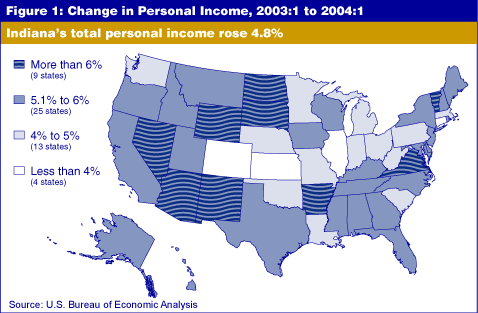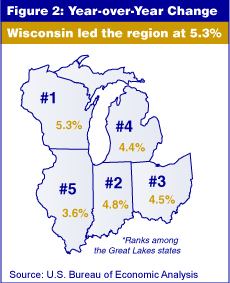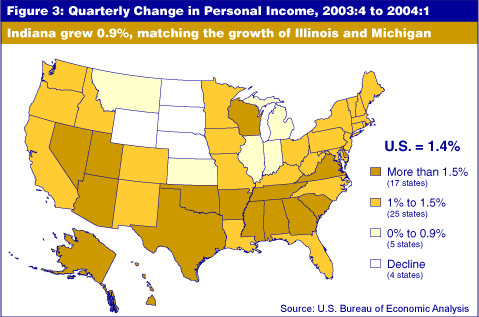Quarterly Personal Income: Comparing Performance
The total volume of personal income in Indiana grew to $184 billion in the first quarter of 2004, up from $175 billion in the first quarter of 2003. Personal income estimates for all states were released on June 29 by the U.S. Bureau of Economic Analysis. Personal income includes income from work earnings, dividends, interest, rent and transfer payments (such as welfare and unemployment compensation).
The Past Year
- Indiana had quarter-to-quarter personal income gains between 1 percent and 1.9 percent each quarter throughout 2003.
- Between first quarter 2003 and first quarter 2004, Indiana’s total personal income rose by 4.8 percent (see Figure 1). Nationally, total personal income grew by 5.2 percent over that same period.

- Indiana had the second highest year-over-year percent change (after Wisconsin) among the Great Lakes states and ranked 35th nationwide (see Figure 2).

The Past Quarter
- Indiana had a modest 0.9 percent increase in personal income between the last quarter of 2003 and the first quarter of 2004 (preliminary), matching the increases of Illinois and Michigan, but less than those for Ohio and Wisconsin.
- Durable goods earnings declined by 3.1 percent, while nondurable goods earnings increased by 2.3 percent. Indiana was alone among the Great Lakes states in posting a decline in durable goods earnings during this time period.
- Construction earnings remained strong with an increase of 4.8 percent, second only to Wisconsin among the Great Lakes states. Earnings in the financial services sector posted gains of 3.5 percent.

- There is significant fluctuation in rankings for most states’ percent change for each preceding quarter (see Table 1). Caution is advised in using these quarter-to-quarter rankings because many factors play into the variability of the ranks. Rather, focusing on the short- and long-term trends among states can provide a better measure of relative progress. As with many Midwestern and Eastern states, Indiana is doing well when compared to its neighbors, but not so well when compared to states in the South and West, many of which are matching or surpassing the national average growth rate (see Figure 3).

Carol O. Rogers
Associate Director, Indiana Business Research Center,
Kelley School of Business, Indiana University
